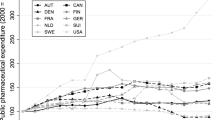Abstract
There are important fundamental links among the efficiency of pharmaceutical manufacturing, drug prices, and public health in the United States. This article seeks to probe these links because recent research (by academics and even the US Food and Drug Administration) suggests there are significant opportunities to improve the manufacturing processes for pharmaceuticals. Two models are developed that consider the impact of reduced manufacturing costs on pharmaceutical prices and firm profits. The two models effectively bound the range of potential future benefits from greater manufacturing efficiency and estimate that, for example, a 30% reduction in manufacturing costs will generate between $1.0 and $12.3 trillion in social value to the United States.
Similar content being viewed by others
References
US Food and Drug Administration. Innovation or stagnation: challenge and opportunity on the critical path to new medicinal products. 2004. Available at: http://www.fda.gov/cdrh/ocd/criticalpath.html. Accessed May 5, 2006.
Bruttin F, Dean D. The Metamorphosis of Manufacturing—From Art to Science. Somers, NY: 2005. IBM Institute for Business Value, IBM Corp., Publication G510-4034-01.
Dean D, Bruttin F. Risk and the economics of regulatory compliance. PDA J Pharm Technol., 2000; 54:253–263.
Pisano G. The Development Factory—Unlocking the Potential of Process Innovation: Lessons From Pharmaceuticals and Biotechnology. Cambridge, MA: Harvard Business School Press; 1997.
Dean D, Bruttin F. Discovery is not enough—how a new compliance agenda is changing the face of the industry. Drug Discovery World. 2005:9–14.
Cooney C. Benchmarking pharmaceutical manufacturing performance. Working paper in: MIT Program on the Pharmaceutical Industry (POPI); Cambridge, MA; 1996:33–96.
Nelson R, Winter S. An Evolutionary Theory of Economic Change. Cambridge, MA: Harvard University Press; 1982.
Caves R, Whinston M, Hurwitz M. Patent expiration, entry, and competition in the US pharmaceutical industry. Brookings Papers on Economic Activity: Microeconomics; 1991:1–66.
Comanor W. The political economy of the pharmaceutical industry. J Econ Lit. 1986; 24.
Tirole J. The Theory of Industrial Organization. Cambridge, MA: MIT Press; 1988.
Coulson E, Stuart B. Insurance choice and the demand for prescription drugs. South Econ J. 1995;61:1146–1157.
Santerre R, Vernon J. Simulating Consumer Gains From a Ceiling on Drug Prices. Cambridge, MA: National Bureau of Economic Research; 2005. Working Paper 11139.
Abbott T, Vernon J. A Financial Simulation Model of the Firm Pharmaceutical R&D Investment Decision: Implications for a New US Price Control Policy. Cambridge, MA: National Bureau of Economic Research; 2005. Working Paper 11114.
Patented Medicine Prices Review Board. 2004 annual report. Available at: http://www.pmprb-cepmb.gc.ca/english/view.asp?x=436&mid=383. Accessed August 9, 2005.
Office of Management and Budget. Circular A-94, Transmittal Memo No. 64. Available at: http://www.whitehouse.gov/omb/circulars/a094/a094.html. Accessed August 9, 2005.
Reinhardt U. Perspectives on the pharmaceutical industry. Health Aff 2001;20(5):136–149.
Vernon J. Examining the link between price regulation and pharmaceutical R&D investment. Health Econ. 2005;14:1–17.
Pharmaceutical Research and Manufacturers of America. Pharmaceutical industry profile. Available at: http://www.phrma.org/publications/publications//2005-03-171143.pdf. Accessed August 9, 2005.
Scherer F. The link between gross profitability and pharmaceutical R&D spending. Health Aff. 2001;20:216–220.
DiMasi JA, Hansen RW, Grabowski HG. The price of innovation: new estimates of drug development costs. J Health Econ. 2003;22:151–185.
Brealey R, Myers S. Principles of Corporate Finance. New York, NY: McGraw-Hill/Irwin; 2003.
Vernon J. New evidence on drug price controls. Regulation. 2004;27:13–14.
Golec J, Vernon J. Pharmaceutical reimportation: the European experience—what the United States can expect. Managed Care. 2004;13.
Lichtenberg. Sources of U.S. Longevity Increase, 1960-1997. Cambridge, MA: National Bureau of Economic Research; 2002. Working Paper 8755.
Murphy K, Topel R. Measuring the Gains from Medical Research. University of Chicago Press; 2003.
World Fact Book. Central Intelligence Agency (CIA). Available at: http://www.cia.gov/cia/publications/factbook/rankorder/2001rank.html. Accessed August 9, 2005.
Author information
Authors and Affiliations
Corresponding author
Rights and permissions
About this article
Cite this article
Vernon, J.A., Hughen, W.K. & Trujillo, A.J. Pharmaceutical Manufacturing Efficiency, Drug Prices, and Public Health: Examining the Causal Links. Ther Innov Regul Sci 41, 229–239 (2007). https://doi.org/10.1177/009286150704100217
Published:
Issue Date:
DOI: https://doi.org/10.1177/009286150704100217



